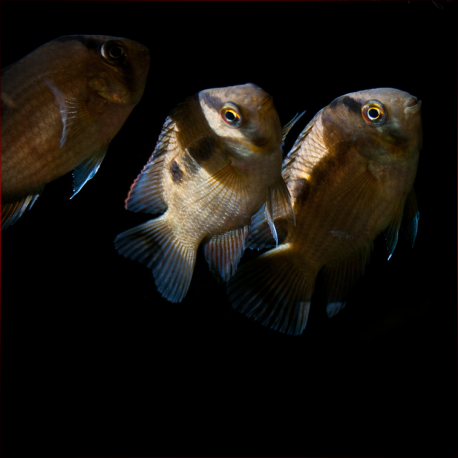More info
Datasheet
| Minimum Tank Size | 80 litres / 21.13 US gallons |
| Maximum Size | 11.0cm / 4.33inches |
| Temperature | 21°C / 69.80°F - 28°C / 82.40°F |
| Hardness | 2.02dgH / 36ppm - 15.02dgH / 268ppm |
| pH | 4.0-7.5 |
General Description
The Cleithracara Maronii, commonly known as Keyhole Cichlid, is easily recognizable by the distinct 'keyhole' marking on its body. Belonging to the family Cichlidae, this species is monotypic under the Cleithracara genus. Adult males grow significantly larger than females and develop elongated dorsal and anal fins. It is a peaceful fish, unless breeding, and typically does not prey on fish larger than a few millimeters.
Aquarium Setup
For a comfortable environment, the Keyhole Cichlid requires a tank size of at least 80 litres with a well-structured setup. With an assortment of hiding spots like ceramic flowerpots and plastic piping, this fish thrives in most planted aquariums. Water quality is crucial, with pH levels between 4.0-7.5 and temperatures maintained at 21-28°C. High flow rates should be avoided to prevent stress on the fish.
Behaviour
The Keyhole Cichlid is known for its non-aggressive nature, except during breeding periods. It tends to seek safety among plants, woody structures, or leaf litter when sensing danger. These cichlids exhibit schooling behavior and feel secure in the presence of small, peaceful species that enjoy similar environmental conditions. Upon reaching sexual maturity, they form pairs that guard a territory while breeding.
Feeding and Diet
This species is an omnivore, feeding on benthic invertebrates and organic detritus in the wild. In captivity, they readily accept a varied diet comprising prepared foods, live, or frozen bloodworm, Artemia, and Daphnia. Homemade gelatine-bound recipes with a mix of dried fish food, puréed shellfish, fruits, and vegetables are recommended for optimal health.
Reproduction & Dimorphism
Keyhole Cichlids are biparental, monogamous substrate spawners. Successful breeding requires a good diet and meticulous tank maintenance. The eggs are attached to solid surfaces, with the female guarding them during incubation, while the male defends the territory. Sexually mature males grow larger than females, displaying extended dorsal and anal fins.
Habitat and Distribution
Found in slow-moving blackwater streams with low mineral content and pH levels as low as 4.0-5.0, this species inhabits regions scattered across French Guiana, Guyana, Suriname, and Venezuela, including the Orinoco delta and Trinidad. Its habitat consists of substrates abundant in fallen leaves, branches, and submerged tree roots, often accompanied by aquatic plants like Cabomba and Marsilea.

